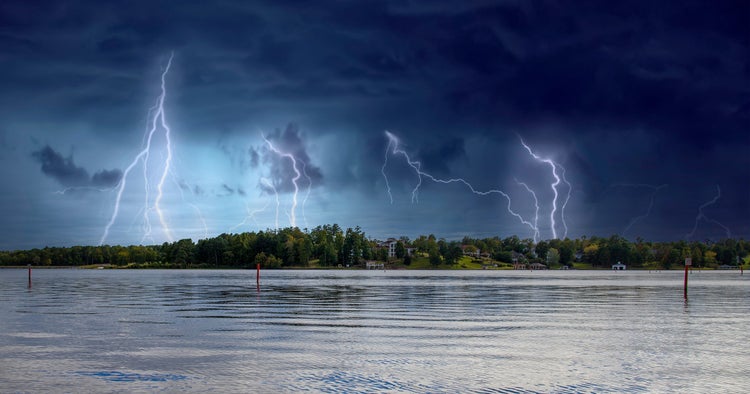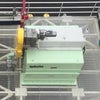Water Intake Screens Vs. Environmental Extremes
How new water screen technologies perform against climate threats
- Insights
- February 19, 2025

Every business that uses a water intake—from desalination and power plants to refineries and farms—relies on water-screening technology. Water screens help ensure the water supply that powers your business and protect downstream equipment. They must also handle whatever challenges their environment presents.
With a changing climate, novel threats arise more often. Hydrolox Project Manager Gareth Evans observes, “We’re seeing the impacts of climate change, and we’ve got to adapt to it.” Around the world, more extreme weather patterns are directly affecting water intakes. Whether it’s both flood and drought conditions in the UK or the “jellification” of oceans in the Middle East, water intakes will likely continue to encounter new and drastic environmental concerns. Facilities that rely on water screening should consider upgrading their screening technology to cope with our changing world.
We spoke with our experts around the world about environmental impacts to water screens. What can businesses do to combat these threats?
Water Screens vs. Corrosion
According to a study by the National Association of Corrosion Engineers (NACE), the global cost of corrosion is approximately $2.5 trillion per year. It further states that effective corrosion control practices could save 15–35% of this cost. Hydrolox Account Manager Gianluca Genchi notes that “repairing corrosion comes with a hefty price tag; thus, preventing it is of significant importance.”
Working with power plants and desalination facilities on Florida’s coastline, Hydrolox Account Manager Dan Ross found that corrosion issues are common with traditional chain-driven water screens in salt water: “They start to rust immediately. It starts in days. And it’s very difficult to maintain in those environments.”
Our mesh is what really separates us from the competition.
Dan Ross
Hydrolox Account Manager
By redesigning traveling water screens, we created a technology uniquely suited to corrosive environments. According to Ross, “Our mesh is what really separates us from the competition.” The non-metallic, engineered polymer screens—combined with a fiberglass hood housing for the motor—uniquely prevent corrosion and ensure optimal screen operation.
Hydrolox Corrosion Prevention: Fiberglass hoods / No metal carrier chains / No submerged serviceable parts / Engineered polymer screen material
Water Screens vs. Biofouling and Heavy Debris
Water intake screens’ purpose is to screen out debris, flora, and fauna, and to protect downstream equipment. They may also be used to protect endangered wildlife. Reflecting on the conditions that screens encounter in oceans and gulf waters, Ross states, “It’s salt water; it’s got a lot of aquatic life in it. And that presents problems—whether it’s a jellyfish swarm or sargassum blooms. That’s what screens face daily.”
Many sites have experienced increased biofouling over recent years. Evans confirms, “Many customers—depending on where they’re based and what their waters are like—say they’re seeing an increase in biofouling-related growth and worsening environmental conditions.”
Organisms and debris can block water intake structures, reducing the flow or—in extreme cases—breaking the equipment. Even when avoiding total shutdown or breakage, water intake screen clogs take their toll on operations. Accumulated organisms or plant matter result in increased head loss and overall operational efficiency declines.
A ScienceDirect® review of macrofouling remediation strategies for water intakes of desalination and other industrial plants elaborates:
“Fouling organisms thrive in intake structures due to optimal conditions, including sufficient oxygen and nutrients from the continuous turbulent flow of seawater, coupled with the absence of light and predators within the structures.”
It also states that “for macrofouling remediation technologies to be viable on a large scale, they need to be maintenance-free, robust, and cost-effective.”
It’s a fully automated system; there’s very little manual intervention required.
Karl Bousfield
Hydrolox Account Manager
According to Hydrolox Account Manager Karl Bousfield, “In cases of increased head loss due to debris clogging, you want screens to start automatically and start cleaning—this ensures the differential will equalize. It’s a fully automated system; there's very little manual intervention required. So, you’re always presenting a clean screen to the inflow and getting the maximum flow with the lowest head loss. The screen will optimize rotation speed based on the environmental conditions.”
Customer Success: Debris Handling and Algae Growth
Find out how two water treatment facilities stopped filamentous algae growth, automated debris removal, and reduced maintenance hours by 96%.
Water Screens vs. Storms and Flooding
Handling debris is a normal requirement for water screens, but they’re truly put to the test in extreme weather events. “Increasingly intense storms or different events like hurricanes create problems,” says Ross. “There could be a massive amount of debris—from the storm run-off, from trees and landscaping structures—that gets washed into the water body and potentially drawn into the intake structure.”
Traditional screens aren’t designed to handle the extreme force of heavy debris loads. Ross explains, “You need your screen frame and mesh to be strong and you want to pair that with robust sprocket engagement. This way, when there’s a major weather event and a lot of pressure against the screen itself, you reduce the risk of screen failure.”
Flooding is a growing concern worldwide. Bousfield surmises, “We’re seeing these flood levels happen a lot more often than once in 100 years. In the UK, we’re seeing one-in-200-year flood events happening three or four times in a 5-year period.”
Floods typically force heavy debris loads on water intake screens. Rising water levels also endanger facilities with the threat of debris carry-over if the waterline rises above the screens. When screens clog or simply aren’t built to handle high water levels, carry-over is common and downstream operations suffer.
I think that's the benefit of working with Hydrolox—we can custom design to suit each application.
Karl Bousfield
Hydrolox Account Manager
Specifying for your needs is crucial when choosing water intake screens. According to Bousfield, “Every site is different, and every application is different. I think that’s the benefit of working with Hydrolox—we can custom design to suit each application.”
He continues, “We size the screens to take into account the flood levels because we want to protect the technology and the facility from the harm these floods can bring. We want to make sure that the system stays operational throughout those events.”
Considering a site’s flood levels, Bousfield adds, “It depends on the site and what floodplain is available. The flood plan allowance can vary from one-in-100 plus 20% to one-in-1,000.” A one-in-1,000-year flood plan may sound extreme; it is. But for some areas, this level of protection is necessary.
“Take, for example, the River Tyne in northern England, where we’ve worked on a one-in-1,000-year plan. It’s very wide, but with steep sides and a massive catchment. So, when they have flood events, it's a massive amount of water,” Bousfield shares. “The lowest water level is 1.2 meters; that's about 3.5 feet. At flood level, we’re at 9.1 meters [30 feet]. The swing is that different. And we built screens 12.2-meters [40-feet] tall to account for that.”
New Technology Wins
While Hydrolox screens combat various environmental threats, they also protect fragile and endangered life forms. In fact, Hydrolox screens meet every known environmental regulation. This includes strict protections such as the UK Eels Regulations, the NOAA NMFS guidelines for salmonid protection, and the U.S. Environmental Protection Agency’s 316(b) legislation.
Hydrolox engineered polymer mesh and chainless drive mechanism provide countless benefits against many climate-related threats, outperforming the competition in the long run. But chain-driven screens—despite their flaws—remain a common choice. Ross notes, “Traveling water screens have been around forever, and they’ve basically had the same design forever. Maintenance departments—or engineering or purchasing departments—tend to look at older technology because that’s what most people use.”
Many decision-makers consider constant maintenance and frequent screen replacements to be necessary parts of ownership. But Hydrolox water screens are changing that pattern. “You don't need to spend large sums of money refurbishing your old [water screens] every couple of years,” shares Ross. “If you do, you’re leaving money on the table. We’ve got screens that have been in the water for 20 years that haven’t needed a major overhaul and don’t have maintenance issues.”
As climate events increase in impact and frequency, you can rely on Hydrolox screens’ robust, reliable technology—now and in the future. Hydrolox experts have extensive experience delivering challenging projects in fields ranging from municipal drinking water to nuclear power. To protect your business from a changing climate, it’s wise to consider changing your water screens. There’s a Hydrolox solution for every region and industry.
Optimal Water Screens for Your Environment
Contact our Customer Service Team to discuss how Hydrolox traveling water screens can meet your specific needs
